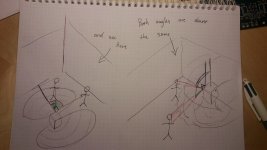Hello all, and especially you who have a single dipole sub or have tested one.
What I'm wondering is if the side nulls caused by a single dipole sub are hearable when you walk around the room or if the reflections make them unhearable and in practice you get equal bass response everywhere in the room.
If this is a problem I have one idea to "solve" it, but before I go down that path I thought I'd check with you people
What I'm wondering is if the side nulls caused by a single dipole sub are hearable when you walk around the room or if the reflections make them unhearable and in practice you get equal bass response everywhere in the room.
If this is a problem I have one idea to "solve" it, but before I go down that path I thought I'd check with you people
Ah, then let's present the idea I have been toying with:
What about flipping the dipole sub such that outputs are upwards and downwards and the null is on the horizontal plane? Shouldn't the bass then spread in the horizontal plane more like a monopole, and be much easier to equalize evenly in the room?
What made me think was my H-frame midbass test, I investigated building a normal such frame and placing an omni ontop of it but I ofc got a dipole response so when I moved to the side of the speaker the I got much less midbass. After a while I realized it didn't integrate well with the omni and after a little time more I tried in desperation to mount the H-baffle upwards instead and it worked better than I ever thought it would. It worked so well my next step is to test to build an upwards mounted U-frame for the midbass.
And if it works for midbass, then shouldn't it work for subbass also?
What about flipping the dipole sub such that outputs are upwards and downwards and the null is on the horizontal plane? Shouldn't the bass then spread in the horizontal plane more like a monopole, and be much easier to equalize evenly in the room?
What made me think was my H-frame midbass test, I investigated building a normal such frame and placing an omni ontop of it but I ofc got a dipole response so when I moved to the side of the speaker the I got much less midbass. After a while I realized it didn't integrate well with the omni and after a little time more I tried in desperation to mount the H-baffle upwards instead and it worked better than I ever thought it would. It worked so well my next step is to test to build an upwards mounted U-frame for the midbass.
And if it works for midbass, then shouldn't it work for subbass also?
We have two opposite poles of high pressure sitting very closely, much-much close than half wavelength. Thus, there is strong leak between them. It is the cause of low efficiency.

As far as the wave moves away, this leak is decreasing.
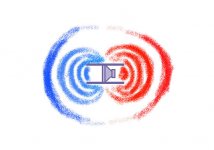
So, any restrictions and limitations along axis of wave propagation will decrease the efficiency.
As we speak about wavelengths comparable with room size, the best place for dipole subwoofer is center of the room. Something like this.
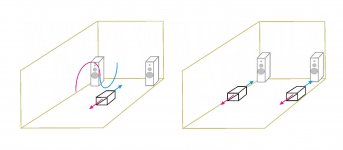
There is zero node at perpendicular axis of the dipole.
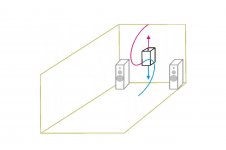
But we can hear it because of there are variations of pressure while the wave shape is being converted by room.
Placing in this way works too but there is problem, one of the speakers is always out of phase.
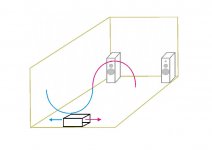
I have ripole in small room. Small size allows it to be placed between wall and sofa.
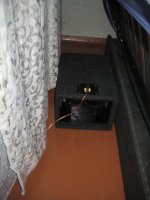
So, partially they restrict to the leak between poles. In other words, this space works like long, leaking, additional frame.

As far as the wave moves away, this leak is decreasing.

So, any restrictions and limitations along axis of wave propagation will decrease the efficiency.
As we speak about wavelengths comparable with room size, the best place for dipole subwoofer is center of the room. Something like this.

There is zero node at perpendicular axis of the dipole.

But we can hear it because of there are variations of pressure while the wave shape is being converted by room.
Placing in this way works too but there is problem, one of the speakers is always out of phase.

I have ripole in small room. Small size allows it to be placed between wall and sofa.

So, partially they restrict to the leak between poles. In other words, this space works like long, leaking, additional frame.
I may be wrong, but I seem to think that the standing waves inside the room and the modes that relate to that will have the greatest effect upon the measured results and how a sub sounds as you move around the room.
Aiming the sub "up", which in this case is a dipole causes greater coupling to one side of the sub than the other, to the floor. That may or may not be an advantage.
But there is a problem. Mechanically, the cone is not designed to work against gravity for long. It will sag over time. You could decide to flip your symmetrical speaker cabinet over, invert it every 30 days or so, and be ok. Don't forget now!
The response wrt the floor coupling is just a gut feeling...
_-_-bear
Aiming the sub "up", which in this case is a dipole causes greater coupling to one side of the sub than the other, to the floor. That may or may not be an advantage.
But there is a problem. Mechanically, the cone is not designed to work against gravity for long. It will sag over time. You could decide to flip your symmetrical speaker cabinet over, invert it every 30 days or so, and be ok. Don't forget now!
The response wrt the floor coupling is just a gut feeling...
_-_-bear
Cone sag wouldn't be an issue since I would do an W-frame, the cones are still mounted horizontally while the openings would then be upwards and downwards.
My regular speakers are upwards mounted omnis so what I'm trying to achieve is to make the horizontal dispersion pattern equal in all directions. If I loose a little output by sitting in or close to a null that's ok as long as I get the dispersion I want.
My regular speakers are upwards mounted omnis so what I'm trying to achieve is to make the horizontal dispersion pattern equal in all directions. If I loose a little output by sitting in or close to a null that's ok as long as I get the dispersion I want.
What about flipping the dipole sub such that outputs are upwards and downwards and the null is on the horizontal plane? Shouldn't the bass then spread in the horizontal plane more like a monopole, and be much easier to equalize evenly in the room?
The whole idea is flawed in my opinion.
Flipping the speaker 90 degrees will not change the fact that you still have a room with standing wave modes and boundary reflections.
You could also flip the room 90 degrees. It would be just about the same.
The whole idea is flawed in my opinion.
Flipping the speaker 90 degrees will not change the fact that you still have a room with standing wave modes and boundary reflections.
You could also flip the room 90 degrees. It would be just about the same.
Yes but the 90 degree nulls on the woofer would instead of being in the horizontal plane be moved to the vertical plane. Shoulnd't the response then change less when I move around than if I had a normal horizontal version and moved into the null angle?
Like in my awesome picture here =) The angle difference between two different listening positions would be very similar fairly independent of where in the room I would listen if the sub was vertical.
Attachments
fairly independent of where in the room I would listen
The room at these freqs has much more influence than you think. If this had the effect you describe we would know about it by now. Is there really a null (no sound), or is this just theory in an anechoic chamber? This is an easy experiment for someone with this kind of sub, any volunteers?
The room at these freqs has much more influence than you think. If this had the effect you describe we would know about it by now. Is there really a null (no sound), or is this just theory in an anechoic chamber? This is an easy experiment for someone with this kind of sub, any volunteers?
At the moment I only have my midbass to test with and a null it is, but only a null if I put my ear next to the side.
While I don't hear a true null further away I still hear a difference in the frequency response when moving around in the room. When I tested with my H-baffle and flip it this disappeared and it sounded much more like my omni. And my theory is that it's because to truly hear a difference and the null I have to change listening height, which is fairly constant.
You are not going to GET omindirectinal bass with a true dipole, by definition...
I get the "H" type rotated vertically, but then one side is firing right into the floor, yes?
Quite right about lack of sag in the case of this design, my oversight. Ha.
The null wrt vertical listening position may be due to cancellation effects between the out of phase wave and the in phase wave... EVEN IF you fired the rear wave and the front wave "in phase" by the time the rear fired wave made it back to the front, albeit at a lower level it will have phase shifted enough so that at some frequency it will subtract... dunno if this is a factor with ur mid set up or not... maybe throw a heavy set of padded moving blankets over the rear radiation and see how that effects what you hear??
_-_-bear
I get the "H" type rotated vertically, but then one side is firing right into the floor, yes?
Quite right about lack of sag in the case of this design, my oversight. Ha.
The null wrt vertical listening position may be due to cancellation effects between the out of phase wave and the in phase wave... EVEN IF you fired the rear wave and the front wave "in phase" by the time the rear fired wave made it back to the front, albeit at a lower level it will have phase shifted enough so that at some frequency it will subtract... dunno if this is a factor with ur mid set up or not... maybe throw a heavy set of padded moving blankets over the rear radiation and see how that effects what you hear??
_-_-bear
You are not going to GET omindirectinal bass with a true dipole, by definition...
I get the "H" type rotated vertically, but then one side is firing right into the floor, yes?
Quite right about lack of sag in the case of this design, my oversight. Ha.
The null wrt vertical listening position may be due to cancellation effects between the out of phase wave and the in phase wave... EVEN IF you fired the rear wave and the front wave "in phase" by the time the rear fired wave made it back to the front, albeit at a lower level it will have phase shifted enough so that at some frequency it will subtract... dunno if this is a factor with ur mid set up or not... maybe throw a heavy set of padded moving blankets over the rear radiation and see how that effects what you hear??
_-_-bear
Yes ofc, one side fires down into the floor, so in practice I would listen to the reflected sound from the floor and roof, probably mostly from the roof. What I wish to research by testing is if it's a problem in practice that I sit in the null or if I would get good enough output from the reflected sound, which I believe I will.
And about damping: current plan is to test an U-frame for midbss which should reduce rear radiation and let it mate easier with my omni mids. What I wish to test is to have undamped such that it's dipole at lower frequencies but approaching monopole omni at it's resonance.
ummm... rotate the sub on axis so that the nulls are not in the main listening area? Assuming the cause is due to a radiation pattern and not standing waves in the room...
_-_-bear
That would be the ideal solution if it would work, but it might not since my goal is to not have a main listening area at all but rather have the whole room as the listening area.
Dum dum dum... Thread revival!
I just got another question in my head... especially for you with several dipole subs:
Have you tested to instead of placing the subs beside the normal speakers to pseudo-randomly place them around the room similar to the much talked about multi-monopole-subs-technique but with dipole subs instead? And if you have, did this give equal frequency response all over the room?
I just got another question in my head... especially for you with several dipole subs:
Have you tested to instead of placing the subs beside the normal speakers to pseudo-randomly place them around the room similar to the much talked about multi-monopole-subs-technique but with dipole subs instead? And if you have, did this give equal frequency response all over the room?
- Status
- This old topic is closed. If you want to reopen this topic, contact a moderator using the "Report Post" button.
- Home
- Loudspeakers
- Subwoofers
- Single dipole sub users: does response change when you move around?
